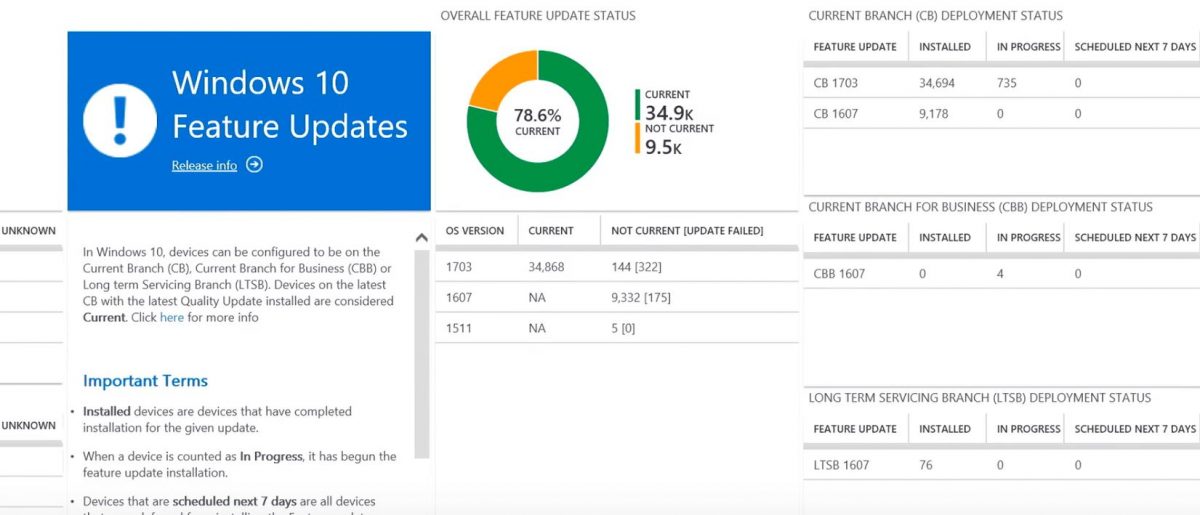The Windows 10 operating system introduces a new way to build, deploy, and service Windows: Windows as a service. Following are the overview of the release model, particularly the Semi-Annual Channel.
Build:
With Windows 10, new features will be delivered to the Windows Insider community as soon as possible — during the development cycle, through a process called flighting — so that organizations can see exactly what Microsoft is developing and start their testing as soon as possible.
Deploying:
Deploying Windows 10 is simpler than with previous versions of Windows. When migrating from earlier versions of Windows, an easy in-place upgrade process can be used to automatically preserve all apps, settings, and data. And once running Windows 10, deployment of Windows 10 feature updates will be equally simple.
One of the biggest challenges for organizations when it comes to deploying a new version of Windows is compatibility testing.
Application & Device compatibility:
Application compatibility testing has historically been a burden when approaching a Windows deployment or upgrade. For the most important business-critical applications, organizations should still perform testing on a regular basis to validate compatibility with new builds. For remaining applications, consider validating them as part of a pilot deployment process to reduce the time spent on compatibility testing.
Device compatibility in Windows 10 is also very strong; new hardware is not needed for Windows 10 as any device capable of running Windows 7 or later can run Windows 10.
Deployment Cycle
With Windows 10, there are two release types:
- Feature updates that add new functionality twice per year.
With Windows 10, Microsoft will package new features into feature updates that can be deployed using existing management tools. Feature updates delivered twice per year, around March and September.
- Quality updates that provide security and reliability fixes at least once a month. In Windows administrators will see one cumulative monthly update that supersedes the previous month’s update, containing both security and non-security fixes.
Servicing Channel:
With Windows 10, organizations will need to change the way they approach deploying updates. Servicing channels are the first way to separate users into deployment groups for and quality updates.
To align with this new update delivery model, Windows 10 has three servicing channels, each of which provides different levels of flexibility over when these updates are delivered to client computers. Followings are three servicing .
- Windows Insider provides organizations with the opportunity to test and provide feedback on features that will be shipped in the next feature update. With Windows 10, feature flighting enables Windows Insiders to consume and deploy preproduction code to their test machines, gaining early visibility into the next build.
- Semi-Annual provides new functionality with twice-per-year feature update releases. Organizations can choose when to deploy updates from the Semi-Annual Channel. servicing tools, feature updates can be delayed for up to 365 days.
When Microsoft officially releases a feature update for Windows 10, it is made available to any PC not configured to defer feature updates so that those devices can immediately install it. Organizations that use Windows Server Update Services (WSUS), Microsoft System Center Configuration Manager, or Windows Update for Business, however, can defer feature updates to selective devices by withholding their approval and deployment.
- Long-Term Annual Channel: Provide new feature releases two to three years, this is designed for special devices, like medical, PoS, ATM or defence etc.
Servicing tools
There are many tools with which IT pros can service Windows as a service. Each option has its pros and cons.
Deployment Ring
For Windows as a service, maintenance is ongoing and iterative. Deploying previous versions of Windows required organizations to build sets of users to roll out the changes in phases.
They are simply a method by which to separate machines into a deployment timeline. Each deployment ring should reduce the risk of issues derived from the deployment of the feature updates by gradually deploying the update to entire departments. As previously mentioned, consider including a portion of each department’s employees in several deployment rings. Like
